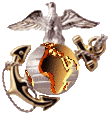Situation Leading Up to Operations Stone, Desoto, Deckhouse/Desoto, Union, and Union II
The buildup of regular NVA forces along the DMZ attracted command attention, but the fighting there was only one segment of the I Corps-Ill MAF campaign. The 1st Marine Division, in the southern portion of the III MAF zone of operations, was fighting a three-pronged war. Marine operations of battalion size or larger extended to the outer periphery of the division's TAOR to destroy North Vietnamese units and Viet Cong main forces and base areas, while company-size and smaller counter-guerrilla operations sought to protect both allied installations and the civil population. At the same time, the division provided support for the Vietnamese Government Revolutionary Development Program which was trying to neutralize the guerilla infrastructure.
The area of responsibility of Major General Herman Nickerson, Jr.'s 1st Marine Division consisted of the three southernmost provinces of I Corps: Quang Nam, Quang Tin, and Quang Ngai. This area was important for diverse reasons. It contained a large population, was a rich rice-producing basin, and was a major source of salt. * Furthermore, the tree- covered foothills of the Annamite Mountains jutting into the coastal plain and the numerous rivers pro vided the enemy with natural access to the area.
Forty-three large unit operations, involving a force of at least a battalion, were conducted in southern I Corps during the first six months of 1967. In addition, thousands of small unit operations abetted the larger "sweeps." During the first three months of the year, for example, the 1st Marine Division carried out no less than 36,553 company-size operations, patrols, and ambushes in the Da Nang Tactical Area alone.
These small unit actions occasionally were hard- fought battles with the Viet Cong. One such occur red on 31 January during a patrol approximately 15 kilometers southwest of Da Nang by Company H, 2d Battalion, 1st Marines, commanded by Captain Edward J. Banks. Just before noon, as the company approached the hamlet of Thuy Bo, located immediately west of the north-south railroad, it came under heavy fire from a Viet Cong main-force battalion. The latter's armament included .50-caliber and other automatic weapons which hit several Marines in the lead platoon. The casualties mounted as the enemy gunners' fire found the Marines taking shelter behind low rice paddy dikes. Evacuation of the dead and wounded proved difficult and only one helicopter managed to land and pick up some of the casualties.
Captain Banks requested air and artillery strikes on the enemy force. By 1330, he decided to ask for a quick reaction mission to bring in reinforcements. Supporting arms continued to hit the Viet Cong but did not eliminate the main-force battalion's fire. The Marines had to remain in their exposed positions the rest of the day and all night.
The following morning, the Marine company assaulted the hamlet. There was some gunfire during the assault; however, the enemy battalion had withdrawn during the night. Marine casualties numbered 5 dead and 26 wounded, most of whom were from the lead units on 31 January. One Marine later died from his wounds. The Marines estimated they had killed 101 Viet Cong soldiers.
During the next two days, local Vietnamese peasants brought 22 dead and 18 wounded villagers to the 2d Battalion, 1st Marines command post. These casualties had resulted from air, artillery, and small arms fire. After an investigation, the battalion determined that these civilian casualties were a regrettable corollary to the fighting on 31 January and 1 February.
PAUL MARQUIS WEB MASTER
SOURCE CITATION:
THE ABOVE OPERATIONS ARE CREDITED
TO 1/3 COMBAT HISTORY FILE AND THE BOOK, "SEMPER FI VIETNAM"


